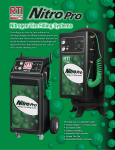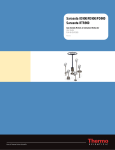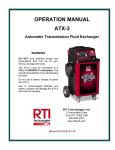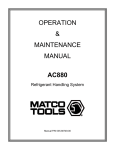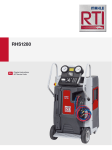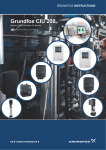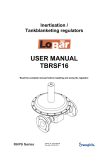Download RTI ID900 User's Manual
Transcript
OPERATION MANUAL ID900 Portable Refrigerant Identifier WARNING Liquid Samples will Damage Unit Do not operate if filter has red flecks. Replace filter every 3 months or after every 25 uses. Always have a spare Call RTI Technologies to order 4075 East Market Street York, Pennsylvania 17402 Phone: 800-468-2321 or 717-840-0678 Fax: 717-755-8304 E-mail: [email protected] Web-site: www.rtitech.com Manual No. 035-80979-00 Table of Contents I. Cautions and Warnings 3 II. Functional Description 4 III. Hardware Description 5 A. Instrument 5 1. Case 5 2. Hanger 5 3. Sample Filter 5 4. Control Panel 5 5. Air Intake Port 5 6. Sample Exhaust Port 5 7. Sample Inlet Port 5 8. Air Detection Sensor 5 9. Control Circuit Board 5 10. Purge Pump 5 11. Power Connector 5 B. Sample Hoses 6 1. R12 Sample Hose 6 2. R134a Sample Hose 6 C. Power Harnesses 6 1. Vehicle Battery Adapter 6 2. Wall Power Adapter 6 D. R134a Tank Adapter Fitting 6 E. Storage Case 6 IV. Operation Procedures 7 A. Pre-Operation Inspection 7 B. Operation Procedure 7 C. Post Operation Procedure 8 V. Maintenance 9 A. Error Codes 9 B. Maintenance Procedures 10 1. Sample Filter Replacement 10 2. Sample Hose Cleaning 10 3. Air Detection Sensor Replacement 11 C. Spare Parts Listing VI. Specifications 11 12 2 I. Cautions and Warnings A. Cautions Never use any sample hose other than those approved for use with the ID900. The use of other hose types may introduce errors and excessive refrigerant loss. Always verify that the refrigerant source to be tested will not emit oil or liquid refrigerant before connecting the ID900 sample hose. Never connect the ID900 to any refrigerant source that exceeds 300-psi pressure. Do not utilize the coupling supplied on the ID900 R134a sample hose for any purpose other than ID900 sampling. The coupler supplied on the R134a hose does not contain check valves and will continually vent refrigerant. Never obstruct the sample exhaust or air intakes of the instrument during use. Do not throw, drop, immerse in liquid or otherwise mistreat the instrument. Always store the instrument in its storage case when not in use. Maintain the cleanliness of the instrument at all times to prevent contamination and prolong life. B. Warnings Read and understand this manual before attempting to utilize the instrument. Flammability Warning: The ID900 is not capable of direct detection and indication of the presence of hydrocarbon compounds. Hydrocarbon compounds may present a flammability hazard when present in sufficient concentrations. The user is cautioned that whenever the ID900 indicates that unknown contaminates are present the potential exists for a hydrocarbon flammability hazard. Sample Filter Warning: Always inspect the outside diameter of the white sample filter element before and after each use of the instrument. As soon as red spots begin to appear on any portion of the white element outside diameter the filter will require replacement. Failure to replace the filter when so indicated may result in out of warranty damage to the instrument. Sample Input Warning: The instrument requires connection of the sample hose to the low or vapor side port of the source vehicle or refrigerant cylinder. Connection of the sample hose to the high or liquid port of the source vehicle or refrigerant cylinder will result in out of warranty damage to the instrument. Additionally, the low side or vapor port shall not emit sample gas in excess of 300 psig or sample gas that contains oil or liquids. Sample Hose Warning: Always inspect the sample hose before and after each use of the instrument. Immediately replace the hose if it appears cracked, crazed, obstructed or fouled with oil. When testing vehicle air conditioning systems make sure that the vehicle is turned off and not running. This will prevent EMI/RFI problems as well as eliminate potential user hazards from moving parts of the vehicle. Air Sensor Warning: The air detection sensor is a chemical fuel cell sensor that will expire after 6-15 months of operation. The user must replace the air detection sensor whenever the instrument indicates as such. Failure to replace the air detection sensor will result in non-functionality of the instrument. Always wear eye and skin protection when working with refrigerants. Escaping refrigerant vapors can freeze upon contact. DO NOT direct refrigerant vapors escaping from the sample hose towards exposed skin or the face. Connection to Power Sources greater than 14VDC could cause “Out of Warranty” damage. Connection to a battery which is not fully charged or is smaller than a typical car battery, may cause errors in reading. If using the optional wall power adapter, be sure the voltage rating of the adapter (115 or 230 VAC inlet) matches the AC power source. DO NOT use wall power adapter in areas where it could get wet. TO REDUCE THE RISK OF BATTERY EXPLOSION DUE TO SPARK GENERATION: First Connect the RED clip to the positive 12 volt battery terminal; then, connect the BLACK clip to a metal ground location away from the 12 volt battery. 3 II. Functional Description Contamination of refrigerant in air conditioning systems or storage cylinders can lead to component corrosion, component destruction, elevated system head pressure and system failures when utilized by unsuspecting technicians. The ability of a technician to determine refrigerant type and purity is severely hampered by the presence of air when attempting to utilize pressuretemperature relationships. The development of substitute refrigerants further complicates refrigerant identification and purity determination based upon pressure-temperature relationships. The ID900 Automotive Refrigerant Identifier will provide a fast, easy and accurate means to determine refrigerant type and purity in refrigeration systems and refrigerant storage cylinders. The instrument utilizes a combination of infrared and chemical fuel cell technologies to determine purity and contamination levels or refrigerants R12 and R134a as well as air concentrations in both refrigerant types. The instrument is supplied in a storage case that will house all components. R12 and R134a sample hoses are provided as well as a R134a cylinder adapter fitting and a power cord for connection directly to the vehicle battery. An optional wall power adapter is available to permit powering of the instrument directly from standard wall power outlets. Sample gas is admitted into the instrument through the supplied sample hose and presented to the sensing devices. The instrument will provide a digital readout of refrigerant purity, a pass or fail condition and the amount of air contamination. A sample will be considered to be pure, or passed, if the concentration has been determined to be 98% by weight or greater of a single refrigerant. The instrument will also provide the user with a direct readout of unknown compounds that can be R22, hydrocarbons or other refrigerants commonly utilized in blended refrigerant types. All operating instructions are provided to the user through display prompts to avoid mistakes and erroneous readings. The ID900 Automotive Refrigerant Identifier will provide the refrigerant technician with knowledge of refrigerant purity and protection against equipment and air conditioning system damage resulting from contamination. 4 11. Power Connector 11. Power Connector Hanger Serial Number Location 9.Control Circuit Board 4. Control Panel Sensor Housing Sample filter exit tube 8.Air Detection Sensor InletPressure Regulator 10. Purge Pump Air Intake Port 6. Sample exhaust port 1. Case 3. Sample filter Housing screws; 8 total Sample filter inlet valve Sample Inlet Port View with Cover Removed Front View Rear View III. Hardware Description A. Instrument: The instrument houses the basic components required for operation of the ID900 as depicted above. 1. Case: an injection molded plastic housing that houses all internal components. 2. Hanger: connects into the side of the case and provides the user a means to hang the instrument above the working area for hands free operation. 3. Sample Filter: will filter oil mists and particulate from the sample gas admitted into the instrument to provide trouble-free function of the detection and sampling components. 4. Control Panel: consists of a 2-line, 16-character digital display and two pushbutton switches. The display will convey analysis results and instructions to the user. The switches provide a means by which the user can communicate with the instrument microprocessor during use. 5. Air Intake Port: will admit fresh air into the sampling system to permit calibration of the infrared and chemical fuel cell detection devices. 6. Sample Exhaust Port: will emit sample gas that has been analyzed by the instrument. 7. Sample Inlet Port: permits the connection of either a R12 or R134a sample hose to the instrument. 8. Air Detection Sensor: a chemical fuel cell that will detect the amount of air contained within a refrigerant sample. 9. Control Circuit Board: directs all activities of the instrument through the embedded microprocessor. The infrared detection device is also contained on this circuit board and will provide all detection of refrigerant components of the sample gas. 10. Purge Pump: will draw ambient air through the air intake port for the purpose of detection device calibration and instrument sample system purging. 11. Power Connector: will accept the installation of either the standard vehicle battery adapter or the optional wall power adapter to provide the instrument with operating power. 5 B. Sample Hoses 1. R12 Sample Hose: is a 6-foot hose consisting of a nylon inner tube surrounded by a polyurethane outer tube. The hose contains the instrument connection fitting on one end and a ¼” SAE female flare nut on the other end. This hose is to be utilized when sampling from R12 vehicle systems or storage cylinders. 2. R134a Sample Hose: is a 6-foot hose consisting of a nylon inner tube surrounded by a polyurethane outer tube. The hose contains the instrument connection fitting on one end and a R134a low side coupler on the other end. This hose is to be utilized when sampling from R134a vehicle systems or storage cylinders. C. Power Harnesses 1. Vehicle Battery Adapter: is a 6-foot power cable that has an instrument mating connector on one end and vehicle battery connection clips on the other end. This harness is utilized to connect power from the vehicle battery to operate the instrument and avoid the use of extension cords. 2. Wall Power Adapter (Optional): is a 6-foot power cable that has an instrument mating connector on one end and a plug-in power transformer on the other end. This harness is utilized to connect power from either a standard 115 or 220 VAC wall power outlet to provide operating power to the instrument. A separate wall power adapter is provided for 115 or 220 VAC source power. Warning: Verify the wall power adapter AC inlet voltage, either 115 or 230, matches the AC power available. D. R134a Tank Adapter Fitting: provides a conversion of standard R134a cylinder ACME threaded ports to a R134a low side coupler stub. This will permit the use of the instrument R134a sample hose during refrigerant cylinder sampling. E. Storage Case: is a cardboard container that houses the instrument, oxygen sensor, adapter fitting, sample hoses, power adapters and manual during non-use periods. 6 IV. Operation Procedure A. Pre-Operative Inspection 1. Inspect the outside diameter of the white element contained within the sample filter for any signs of red spots. The appearance of red spots anywhere on the outside diameter of the element indicates that the filter requires replacement to avoid fouling of the instrument. 2. Select the R12 or R134a sample hose as dictated by the application. Inspect the hose for cracks, signs of wear, obstruction or fouling. DO NOT use any hose that has any sign of wear. Install the sample hose onto the sample inlet port of the instrument by hand-threading the hose end onto the connector. 3. Inspect the air intake port and sample exhaust port to verify that they are not clogged or obstructed. 4. Inspect the port of the air conditioning system or storage from which the sample will be taken. Verify that the port will emit vapor only and will not emit liquids or oil. 5. Install the Vehicle Battery Adapter or the Wall Power Adapter harness into the power connector of the instrument. B. Operation Procedure 1. Power the instrument by connecting the power harness to the vehicle battery terminals or by plugging the wall power adapter transformer into an appropriate wall outlet. 2. The instrument will begin a warm up period of 30-60 seconds. 3. During the warm up period the user will have the option to enter the local elevation above sea level into the instrument memory. The instrument is sensitive to elevation changes of 500 feet (152 meters) and the local elevation must be entered into the instrument memory upon initial use. Normal barometric variations will not affect the performance of the instrument. Once the elevation has been entered it does not ever require entry again unless the instrument is moved to a new elevation. The screen “USAGE ELEVATION <<<NOT SET>>>“ is displayed during warm-up if the elevation has not been set. Set the elevation to prevent the displaying of this screen during warm-up as directed below. a) During the warm up period depress and hold the “A” and “B” pushbuttons simultaneously until the display reads “USAGE ELEVATION, 400 FEET”. This is the factory setting of 400-feet (122-meters). b) Use the “A” and “B” pushbuttons to adjust the elevation reading to the nearest 100-foot (30-meter) increment to the local elevation. The “A” pushbutton will increase the elevation setting in 100-foot (30-meter) increments. The “B” pushbutton will decrease the elevation setting in 100-foot (30-meter) increments. The elevation setting is adjustable from 0-9000 feet (0-2743 meters) and is displayed during adjustment. c) When the correct setting has been achieved, allow the instrument to sit for approximately 20 seconds while not pushing either of the buttons. The setting will automatically be stored into the instrument memory. Note: Failure to correctly enter the local elevation may result in detection errors. Hang the instrument from vehicle hood or storage cylinder. Note: Laying the unit flat will cause calibration errors and inaccurate readings. 4. The instrument will now draw ambient air into the instrument through the air intake port for approximately 30 seconds. The ambient air will be utilized to calibrate the detection devices and purge the instrument plumbing of residue refrigerant vapors. Note: For proper calibration, the surrounding ambient air must be clear of refrigerant vapors, hydrocarbons and oxygen depleting compounds such as carbon dioxide or carbon monoxide. 7 5. When prompted by the instrument, connect the free end of the sample hose to the vehicle air conditioning system or refrigerant storage cylinder port and press the “A” pushbutton. Sample gas will immediately begin to flow into the instrument. The instrument will require approximately 30 seconds to complete the sample gas analysis. 6. When the analysis has completed immediately disconnect the sample hose from the refrigerant source. Note: The instrument contains no automatic shut-off and refrigerant vapors will continue to flow out of the source as long as the hose is connected. To conserve refrigerant stores and prevent excessive refrigerant venting, DO NOT leave the instrument unattended during analysis cycles and disconnect the sample hose from the source immediately after prompted by the instrument. 7. The results of the analysis will be presented to the user on the instrument display. a) PASS: Indicated whenever a sample is detected to have 98% by weight or greater of R12 or R134a. The refrigerant type and air concentration will be indicated. b) FAIL: Indicated whenever a sample is detected to be a blend of R12 and R134a refrigerants with neither R12 or R134a having 98% by weight or greater concentration. The weight percentages of R12, R134a and air will be indicated. c) FAIL CONTAMINATED: Indicated whenever unknown refrigerant types such as R22 or Hydrocarbons have been detected in concentrations of 4% by weight or greater. No weight concentrations of refrigerants or air are provided in this mode. d) NO REFRIGERANT – CHK HOSE CONN: Indicated whenever a sample is detected that contains 90% by weight or greater air. This condition usually occurs when the R134a sample hose coupler has not been opened, the sample hose has not been connected to the sample source, or if there is no refrigerant present in the sample source. 8. The instrument will keep the analysis results on the display until the user presses the “A” pushbutton. Once the “A” pushbutton is pressed follow the directions on the screen. 9. If another sample run is desired, follow the prior instructions from step 5. If no other sample run is desired disconnect the power harness from the vehicle or the wall outlet to end the routine. C. Post-Operation Procedure 1. Disconnect the sample hose from the instrument sample inlet port. Inspect the hose for signs of wear, cracking, oil fouling or obstruction and replace if necessary. Clean the outside of the hose, coil and stow into the storage case. 2. Inspect the sample filter white element outside diameter for the presence of red spots. If any red spots are found, replace the sample filter as directed in the maintenance procedures. 3. Disconnect the power harness from the instrument, clean, coil and stow into the storage case. 4. Clean the outside of the instrument of dirt, grime, oil, etc. with a moist rag. Do not use cleaning solutions or water on the instrument. Stow the instrument into the storage case. 8 V. Maintenance A. Error Codes and Corrective Actions The instrument is supplied with self-diagnostic software to aid the user in the determination of problems. The software will supply error codes that will direct the user towards specific corrective actions in the event of system failure. ERR.1: Signifies unstable infrared readings due to inconsistent sample gas supply or interference from strong electrical fields. Corrective Actions: 1. If the error code occurs during a sample cycle verify that the sample hose is receiving sample gas from the source connection of at least 5 psig. Also verify that the instrument sample exhaust and air intake ports are not clogged or restricted. 2. If the error code occurs during a calibration cycle verify that the air intake and sample exhaust ports of the instrument are not clogged or obstructed. 3. The unit should be kept away from sources of strong electrical fields such as large compressors, running automobiles, etc. Move the instrument 3-5 feet away from the electrical field source and try again. 4. If the instrument is being utilized outside of the operating temperature range of 45-100oF (7-38oC) allow the instrument to warm or cool to the operating temperature range and try again. The instrument may require additional warm up time after power up before use. 5. To clear the error code power down the instrument. The error code will automatically clear. DETECTOR FAULT: Signifies internal infrared sensor failure due to temperature extremes. Corrective Actions: 1. Allow the instrument to stabilize at room temperature for at least 30 minutes before attempting use. 2. To clear the error code power down the instrument. The error code will automatically clear. CAL. FAULT: Signifies an infrared calibration fault. Corrective Actions: 1. Verify that the air intake and sample exhaust ports of the instrument are not clogged or obstructed. 2. If the instrument is being utilized in an enclosed area, refrigerant vapors may build up in the surrounding atmosphere and be drawn into the intake port during calibration. Move the instrument to a location with fresh ambient air free of refrigerant vapors. Use the instrument in locations that provide adequate ventilation to prevent the accumulation refrigerant vapors in the surrounding atmosphere. 3. Hang the unit so that there is a flow of fresh air around it. 4. To clear the error code power down the instrument. The error code will automatically clear. AIR SENSOR FAULT: Signifies an air detection sensor calibration fault. Corrective Actions: 1. Verify that the air intake and sample exhaust ports of the instrument are not clogged or obstructed. 2. If the instrument is being utilized in an enclosed area oxygen depleting compounds such as carbon dioxide or carbon monoxide may accumulate in the surrounding atmosphere and be drawn into the intake port during calibration. Move the instrument to a location with fresh ambient air free of oxygen depleting compounds. Use the instrument in locations that provide adequate ventilation to prevent the accumulation oxygen depleting compounds in the surrounding atmosphere. 9 Warning: Should it be determined that the air detection calibration failure has been caused by the presence of oxygen depleting compounds in the surrounding atmosphere the use MUST take immediate action to rid the area of such compounds or provide adequate ventilation to prevent such accumulation. The accumulation of oxygen depleting compounds in the surrounding atmosphere will present a human health risk and hazard. 3. To clear the error code power down the instrument. The error code will automatically clear. RECALIBRATION REQUIRED: Signifies that the prior calibration data is too old and requires refreshing. This message will appear whenever a 3 minute period elapses from the prior calibration. Corrective Actions: 1. Remove the sample hose connection from the refrigerant source if so connected. Depress the A button to initiate a new calibration. B. Maintenance Procedures 1. Sample Filter Replacement Inspection Frequency: Inspect the sample filter before and after each use of the instrument. What to look for: Inspect the outside diameter of the white element for the appearance of any red spots or the presence of discoloration. The appearance of red spots or the presence of discoloration will indicate that the sample filter requires replacement. Do not look into the ends of the filter element since the red indicating dye may always be seen from this angle. Failure to replace the sample filter when so indicated may result in out of warranty damage to the instrument. Replacement Procedure: a) Power down the instrument and disconnect the sample hose. b) Obtain a replacement filter. c) Remove the existing filter by pulling it straight up and out of the retaining clip and disconnecting the tube connections. Do not allow the free tube ends to slip back into the instrument. d) Discard the existing filter. e) Install the free ends of the instrument tubes onto the ends of the replacement filter being sure to align the filter flow arrow with the arrow on the instrument case. f) Carefully slide the tubes back into the instrument case and position the filter into its retaining clip on the instrument case. g) Inspect the sample hoses for signs of oil entrapment. The need to replace the sample filter may indicate sample hoses contaminated with oil. Replace or flush the sample hose(s) if oil entrapment is found. 2. Sample Hose Inspection and Cleaning Inspection Frequency: Inspect the sample hose(s) before and after each use of the instrument and after every replacement of the sample filter. What to look for: Inspect the inside diameter of the inner tube for signs of cracking, fouling, oil entrapment, kinks or other signs of wear. Oil contamination can by cleansed by flushing the hose(s) as described below. Hoses that show signs of wear should replaced immediately. Sample Hose Flushing Procedure: a) Remove the hose from the instrument and flush with isopropyl alcohol. Warning: Flush hoses away from sparks, open flames or any other ignition source and in an area with appropriate ventilation. b) Dry the hose by blowing clean, dry oil-free nitrogen or shop air through the inner tube; or; allow the hose to airdry for several hours. Take care not to dry the hose with lubricated shop air. 10 c) 3. When the hose is completely dry inspect the hose for signs of wear as described above. Air Detection Sensor Replacement Inspection Frequency: The instrument will inform the user of possible air detection replacement requirements with the error code Replace Air Sensor. Air Detection Sensor Replacement Procedure: a) Refer to the error code corrective actions and try each suggested action. If the instrument still indicates the error code then the air detection sensor will require replacement. b) Power down the instrument and remove the sample hose from the instrument sample inlet port. c) Turn the instrument onto its face and remove the eight phillips head screws from the rear countersunk holes. d) Carefully remove the instrument case front to expose the internal components. e) Carefully lift the control circuit board and disconnect the air detection sensor harness from the circuit by pulling straight out of the circuit board connector. f) Lift the air detection sensor housing straight up from the instrument off of the support pins and remove the sensor by unthreading. Discard the spent sensor. g) Obtain a replacement air detection sensor, part number 1-16-1013-00-0, and install it into the housing by threading to hand-tight. h) Replace the housing into the instrument by seating the housing through holes over the two case pins. i) Route the sensor harness to the circuit board and plug it into the sensor harness header of the circuit by pressing straight in. The harness is keyed and will only fit securely in one direction. j) Verify that the circuit board is properly positioned onto the mounting studs of the instrument case. k) Secure the housing halves together using the eight phillips head screws. C. Spare Parts Listing Spare parts are available directly from the Neutronics Incorporated Sales or Service Department. To order spare parts contact Neutronics Incorporated by phone at (610) 524-8800 or by fax at (610) 524-8807. Have a shipping name, address and purchase order number ready as well as the model and serial number of the instrument and the part number of the spare part. Spare Part Description Order Part Number User Instruction Manual 035-80979-00 Sample Filter 026-80128-00 11 VI. Specifications Sample Parameters: Vapor only, oil and liquid free, 300 psig (2 MPa) Maximum Detected Compounds: R12, R134a, Air and unknown compounds Sensor Technologies: Non-Dispersive Infrared and Chemical Fuel Cell Refrigerant Sample Size: 0.12 ounces (3.5 grams) per typical sample – weight of vapor loss Power (Standard): Powered by vehicle battery through clip-on adapter harness (10 to 14 VDC). Power (Optional): Powered by line power through plug-in wall adapter harness, 115 VAC unit (OPTIONAL) or 220 VAC unit (OPTIONAL) Operational Temperature Range: 45-100oF (7-38oC) Instrument Weight: 1.5 Lbs. (454 grams) R12/R134a Purity Setpoint: Pass if single refrigerant, R12 or R134a, is detected in concentrations equal to or greater than 98% by weight. Unknown Refrigerant Purity Setpoint: In the presence of detected unknown refrigerant types R12 or R134a is considered pure if detected in concentrations equal to or greater than 96% by weight. Effect of Air Concentrations: Air is not considered a contaminate and will be removed from the weight concentration determination of refrigerants. Air concentrations will only be reported for blends of R12 and R134a refrigerants. SAE J1771: If the refrigerant being tested is identified as contaminated, any visual percentages displayed of CFC-12 (R-12) or HFC-134a (R134a) outside the design certified value is informational and may not be accurate. SAE J1771 Certification Note: This equipment has not been designed certified for contaminate detection of R-124 or R-142B. 12












